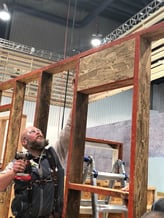 As lumber costs skyrocket across the country, driven by strong homebuilding numbers and residential and commercial renovation projects, cost containment measures become more important for home builders. One effective way to reduce lumber use is advanced framing and it comes with the added benefits of optimized energy efficiency and structural integrity. Yet the shift from traditional to advanced framing can be daunting for some because change is hard. Getting started with online training that focuses on incremental shifts in construction practices that are part of advanced framing techniques may ease the learning curve.
As lumber costs skyrocket across the country, driven by strong homebuilding numbers and residential and commercial renovation projects, cost containment measures become more important for home builders. One effective way to reduce lumber use is advanced framing and it comes with the added benefits of optimized energy efficiency and structural integrity. Yet the shift from traditional to advanced framing can be daunting for some because change is hard. Getting started with online training that focuses on incremental shifts in construction practices that are part of advanced framing techniques may ease the learning curve.
Online training on advanced framing
An excellent resource for homebuilders, framers, code officials, architects, and anyone interested in learning more about advanced framing is this webinar from APA – The Engineered Wood Association. In the webinar, APA Field Representative Warren Hamrick outlines the advantages of advanced framing, including the significant reduction in lumber use and framing labor and increased productivity time for other scheduled trades. The webinar also discusses some of the top concerns builders may express about the practice, one of which is consumer questions about structural integrity.
According to Hamrick, some home buyers may express concern about the structural strength of a home that uses less lumber in framing. Hamrick reports that APA tests show that the wall's structural integrity is not affected when converting from 2 x 4 construction at 16" on center to 2 x 6 construction at 24" on center (o.c.). In fact, tests show that the 2 x 6 at 24" o.c. wall is more than two times stronger when tested at a 9-foot stud height.
The webinar also covers how builders can ease the transition to advanced framing by coordinating with designers, framers, and trades to ensure that details are appropriately addressed in the planning stage. See this Providence Homes profile, which uses advanced framing in constructing their homes and advocates for rigorous training to achieve desired results.
Steps to phasing in advanced framing
Hamrick notes that APA recommends that builders phase in the transition to advanced framing using these four steps:
- Shift to 2 x 6 construction and increase cavity insulation from R-13 to R-20.
- Change the wall framing module from 16" o.c. to 24" o.c. while retaining the use of double top plates to avoid in-line framing.
- Incorporate intersecting wall techniques and energy-efficient corners, beginning with three-stud corners that allow for greater insulation volume and implement energy-efficient headers and single-member framing around openings.
- Eliminate double top plates to reduce thermal bridging.
Conclusion
Stricter energy codes and increasing lumber costs will drive more builders to consider advanced framing, but that won't happen overnight. Training is a critical first step to move from consideration to implementation and realize the benefits of advanced framing techniques, including energy-efficient, durable, cost-effective, and sustainable construction.
Access APA's webinar here. The webinar is approved by AIA and ICC for continuing education credit.
Photo: Builder Matt Whitbeck demonstrates advanced framing techniques in a demo wall.





